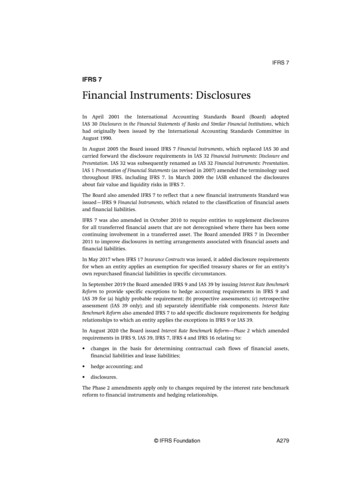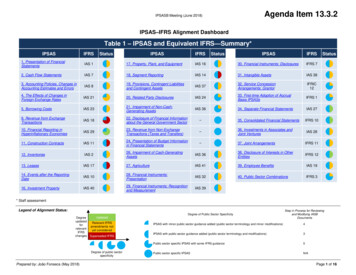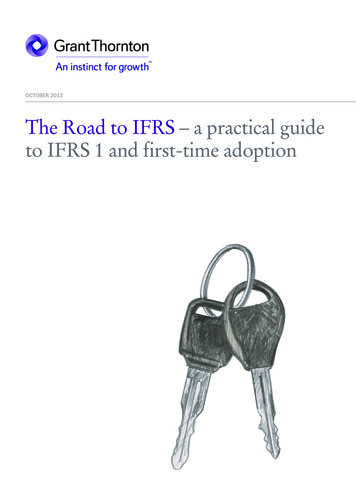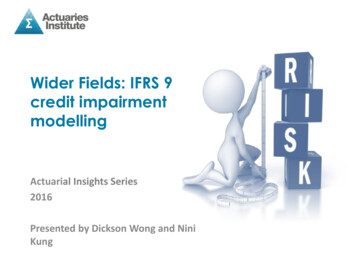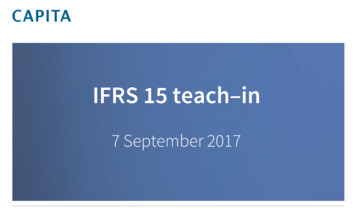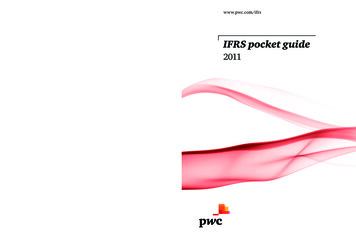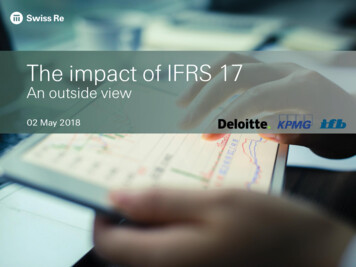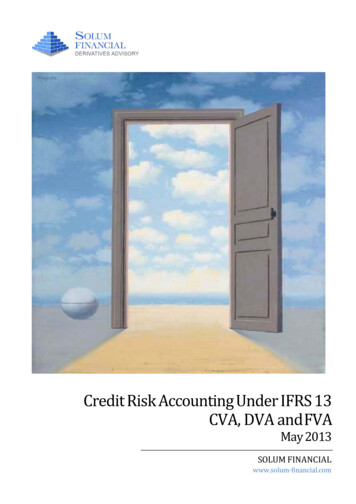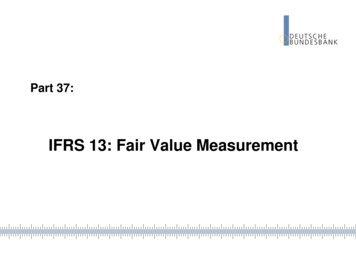
Transcription
Part 37:IFRS 13: Fair Value Measurement
IFRS 13:Fair Value Measurement Scope of Standard: Provides a definition of Fair Value Concentrates in one single standard the measurement thathas to be applied for all other standards, where fair value iscalled for Defines the disclosures which are required about themeasurement of fair value Replaces the previous definition, to be found in the“framework” IFRS 13 applies when another IFRS requires or permits fairvalue measurement, such as IAS 39, IFRS 9 etc, even in“combined measurements” (such as fair value less costs tosell, IFRS 3)Dr. Th. GoswinInternational Accounting Standards2
IFRS 13:Fair Value Measurement Exception: IFRS is explicably not applicable on Share-based payment transactions (IFRS 2) Leasing transactions (IAS 17) Measurements that have some similarities to fair value, butare not fair value, such as “net realizable value” (IAS 2) Here the “old” definition has to be applied: Fair value is a price, that two knowing and willing partners willagree on a transaction on arms length Definition of fair value according to IFRS 13: The price that would be received to sell and asset or paid totransfer a liability in an orderly transaction between marketparticipants at the measurement date (i.e. exit price)Dr. Th. GoswinInternational Accounting Standards3
IFRS 13:Fair Value Measurement Conclusion: This requires an active marketA market in which transactions for the asset or liability takeplace with sufficient frequency and volume to provide pricinginformation on an ongoing basis (which is the case only on asmall minority of the markets of the world) Other definitions within the scope of IFRS 13 Highest and best use: The use of a non-financial asset bymarket participants, that would maximise the value of the asset(e.g. a business) within that asset would be used Most advantageous market: the market that maximises theamount that would be received to purchase an asset(minimizes the amount that would be paid to transfer a liability)after taking into account transaction and transport costs Principal market: biggest marketDr. Th. GoswinInternational Accounting Standards4
IFRS 13:Fair Value Measurement Aim of IFRS 13: achieve consistency and comparability in fairvalue measurement, through creating a fair value hierarchy This categorizes the inputs used in valuation techniques intothree levels If different levels are used to measure fair values, it has to beindicated, that the lowest level of categories is used(example: compound or structured capital market products) Level 1 inputs: Quoted prices at active markets for individual assets orliabilities that can e accessed at measurement date Provides the most reliable source for fair value and can beused without adjustments If the active market would be to small to absorb the totalquantity of an asset, held by an entity, nonetheless the marketprice shall be applied (Balkan, Caucasus, East Africa ?)Dr. Th. GoswinInternational Accounting Standards5
IFRS 13:Fair Value Measurement Level 2 inputs: Inputs other than quoted market prices Must be observable, either direct or indirect Includes: Quoted prices for similar assets and liabilities in activemarkets Quoted prices for identical or similar assets or liabilities inmarkets, that are not activeDr. Th. GoswinInternational Accounting Standards6
IFRS 13:Fair Value Measurement Level 2 inputs: Inputs other than quoted prices that are observable for tehasset or liability, for example Interest rates and yield curves, observable at commonly quotedintervals Implied volatilities Credit spreads Inputs that are derived principally from or corroborated byobservable market data by correlation or other means(Example: pricing hub of the central bank)Dr. Th. GoswinInternational Accounting Standards7
IFRS 13:Fair Value Measurement Level 3 inputs: Unobservable inputs Used in case, that observable inputs are not available Allowed for circumstances, where little if any market activityis available Development of unobservable inputs by the entity, usingbest information available under the given circumstances May include Entity’s own data Information about market participants assumptions Everything that is reasonably availableDr. Th. GoswinInternational Accounting Standards8
IFRS 13:Fair Value Measurement Overview of fair value measurement approach Estimate the price, at which an orderly transaction would take place Requires entities to determine all of the following: Particular asset or liability that is subject of measurement For non-financial asset the valuation premise that is appropriate forthe measurement (consistently with it’s highest and best use) Principal (or most advantageous) market for the asset or liability The valuation techniques (see next slide) appropriate for themeasurement, considering availability of data, to generateassumptions of market participants appreciations Level of hierarchy (level 1 to 3) within which the inputs arecategorizedDr. Th. GoswinInternational Accounting Standards9
IFRS 13:Fair Value Measurement Guidance on measurement Taking into account the characteristics of the asset/liability likea market participant would do (e.g. Condition, location,restrictions on the sale, further use of the asset) Assumption of an orderly transaction at measurement dateunder current market conditions Assumption, that the transaction takes place on the principalmarket, in absence of that, most advantageous market is taken In case of non-financial assets, the highest and best use to betaken into account Measurement of fair value of financial or non-financialinstrument as well as equity instrument assumes it istransferred to a market participant without settlement,extinguishment or cancellation at the measurement dateDr. Th. GoswinInternational Accounting Standards10
IFRS 13:Fair Value Measurement Guidance on measurement Thus transaction costs cannot be part of the market price, butmust be considered separately Fair value of a liability must include non performance risk,including entity’s own credit risk, assuming same nonperformance risk before and after the transfer of the liability(i.e. no change of value after successful completion) Optional exception: Financial liabilities and assets withoffsetting positions in market risk, counterparty risk (Hedgeaccounting) However: as a observation only very few markets aresufficiently active and have the sufficient sizeDr. Th. GoswinInternational Accounting Standards11
IFRS 13:Fair Value Measurement Valuation techniques: Entity uses valuation techniques appropriate in thecircumstances given For which sufficient data are available to measure fair value Maximizing use of observable inputs and minimizing input ofunobservable inputs Objective of using a valuation technique is to estimate theprice at which an orderly transaction would take place Three widely used valuation techniques are accepted: Market approach: uses prices and other relevant informationgenerated by market transactions involving identical orcomparable assets / liabilities Cost approach: reflects the amount that would be necessaryto replace the service capacity of an asset /liabilityDr. Th. GoswinInternational Accounting Standards12
IFRS 13:Fair Value Measurement Valuation techniques: Three widely used valuation techniques are accepted: Income approach: Converts future amounts (cash flows,income, expenses) to a single amount (discounted)reflecting current market expectations about the future. What does that mean: Calculation of discounted cash flowtaking into consideration the current yield curve Market expectation of the future: Does that include expectedinflation development?Dr. Th. GoswinInternational Accounting Standards13
IFRS 13:Fair Value Measurement Disclosure requirements: Separation of recurring and non recurring fair valuemeasurements of assets and liabilities Recurring: Disclosures that other IFRSs require as well Non-recurring: Disclosures, that other IFRSs require inparticular circumstances That means: As fair value accounting is required in numerousstandards, not only financial assets and liabilities areconcerned, but valuation of non-financial assets and liabilitiesas wellDr. Th. GoswinInternational Accounting Standards14
IFRS 13:Fair Value MeasurementSpecial issue: CVA and DVA Covering the area of Credit Risk, related to (OTC) derivatives In case of Receivables and Fixed Income Securities,Counterparty Risk is included in Fair Value (Market Price) In case of Derivatives which are traded on organized markets,the Margin covers counterparty risk However for derivatives, especially OTC, no recognition ofcounterparty risk, tendency of overvaluing of FinancialInstrument Basel II clearly requires the consideration of counterpartyrisk, however no consideration of own counterparty riskDr. Th. GoswinInternational Accounting Standards15
IFRS 13:Fair Value MeasurementSpecial issue: CVA and DVA In practice development of different approaches to covercounterparty risk: Calculation of Counterparty Risk via yield curve and/orexchange riskHowever, Counterparty Risk is very specific and requiresindividual consideration for every market participant Calculation of Counterparty Risk according to credit spreadHowever, systemic risk (i.e. correlation) is not properlyaccounted. In reality, expected loss according to credit spreadis 2 to 1000 times smaller than a properly calculated CVYDr. Th. GoswinInternational Accounting Standards16
IFRS 13:Fair Value MeasurementSpecial issue: CVA and DVA Therefore use of potential exposure approach, 4 steps:1. Development of sufficient number of scenarios by variation ofinterest rates, exchange rates and margins (according to thenature of exposure), can be hundreds of scenarios of eachperiod2. Calculation of Fair Value of derivative for each scenario andfor each moment within the periods3. Calculation of mean value out of all scenarios , as a resultwe get expected value of the exposure.Dr. Th. GoswinInternational Accounting Standards17
IFRS 13:Fair Value MeasurementSpecial issue: CVA and DVA Therefore use of potential exposure approach, 4 steps:3. Calculation separately for positive and negative scenarios Expected positive exposure (EPE) Expected negative exposure (ENE)4. Pricing of expected values by multiplication with creditspreads and discounting Potential exposure approach has two results: Positive exposure Credit Value Adjustment (CVA) Negative exposure Debit Value Adjustment (DVA)Dr. Th. GoswinInternational Accounting Standards18
IFRS 13:Fair Value MeasurementSpecial issue: CVA and DVA This is only valid in case of “Bilateral Approach”Consideration of Credit Risk of the counterparty AND of owncredit riskCalculation, both, of CVA and DVA In “Unilateral Approach” (as a required by Basel II),consideration of counterparty risk only.Therefore only CVA possible only IFRS 13 requires “Bilateral Approach”Dr. Th. GoswinInternational Accounting Standards19
IFRS 13:Fair Value MeasurementSpecial issue: CVA and DVA Example: Calculation of 160 positive and negative schenariosof a 10 year interest rate swap:Dr. Th. GoswinInternational Accounting Standards20
IFRS 13:Fair Value MeasurementSpecial issue: CVA and DVA Example: Calculation mean value of all 78-910-9-16-209-16-21-21-24-25-24-30Dr. Th. GoswinInternational Accounting Standards21
IFRS 13:Fair Value MeasurementSpecial issue: CVA and DVA Example: calculation of exposures in -5-7-7-10-12-15-12-15-16-15-20Dr. Th. GoswinInternational Accounting Standards22
IFRS 13:Fair Value MeasurementSpecial issue: CVA and DVA Calculation of cash flows as difference between fixed andvariable leg. Creation of positive and negative scenarios If own creditworthiness is better than counterparty’s, entity is“net looser” as it has to consider discount for the investment(CVA). In opposite case “net winner”, has to consider add-onfor investment (DVA) In course of time, even if creditworthiness does not change,consideration of real existing exposure instead of theoreticalexposure, especially if FV of Swap is not zero.Dr. Th. GoswinInternational Accounting Standards23
IFRS 13:Fair Value MeasurementSpecial issue: CVA and DVA Example: Calculation of CVA, at beginning of transactionpotential exposuresCredit Spreadcredit charges with 50% 42524211690ENE0-9-16-21-24-25-24-21-16-90from yield curve from yield 00Discount 00,7310,7030,676Cash 0,0160,000ENE*Cr.Sp*50%Summ0,338credit valueadjustment As a result: Initial accounting entryDiscounting expense on Swap CVA: 0,338Dr. Th. GoswinInternational Accounting Standards24
IFRS 13:Fair Value MeasurementSpecial issue: CVA and DVA Example: Rise of FV to 9, however, value is overstatedpotential exposuresCredit Spreadcredit charges with 50% probabilityPeriodDiscount FactorCash 000,0000,7030,000givengivenexplanationfrom yield curve from yield curve from yield curve from yield curveEPE*Cr.Sp*50% ENE*Cr.Sp*50%Summ0,554credit valueadjustment As a result: consecutive accounting entry:Fair Value – CVA 9 – 0,554 8,446 (adjusted FV)Dr. Th. GoswinInternational Accounting Standards25
IFRS 13:Fair Value MeasurementSpecial issue: CVA and DVA IFRS suggests the creation of “Credit Risk Management Framework”FVmeasurementyesValue already incorporates non-performance risknoStep 1: Determine unit of Credit Risk MeasurementStep 2: Apply market participant perspective to abailable informationEntity specific creditspreads or bond yieldsSector specific creditspreads or bond yieldsOther marketinformationStep 3: Calculate Credit Risk AdjustmentStep 4: Allocate Credit Risk Adjustment to individual FV measurementsDr. Th. GoswinInternational Accounting Standards26
Negative exposure Debit Value Adjustment (DVA) Dr. Th. Goswin International Accounting . Special issue: CVA and DVA This is only valid in case of "Bilateral Approach" Consideration of Credit Risk of the counterparty AND of own credit risk Calculation, both, of CVA and DVA In "Unilateral Approach" (as a required by Basel II), .
